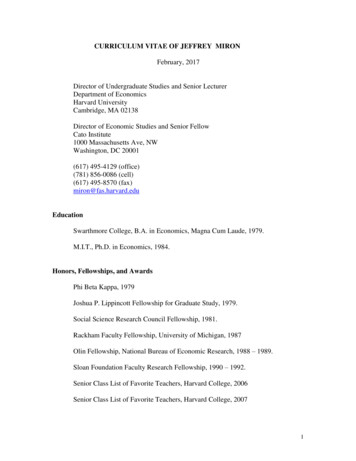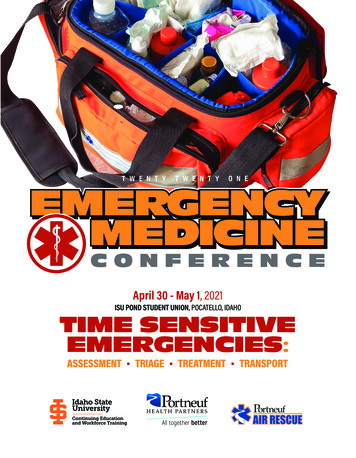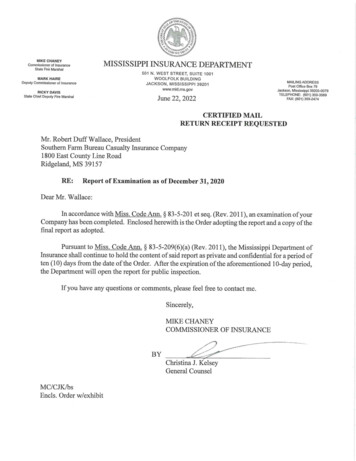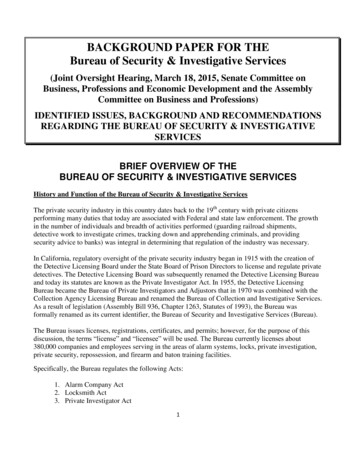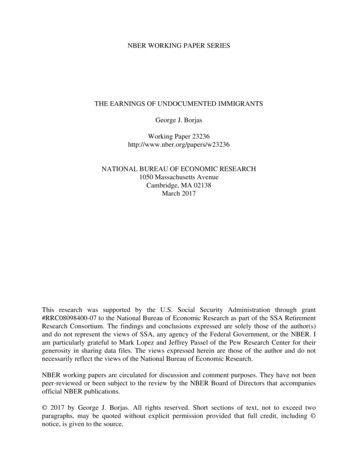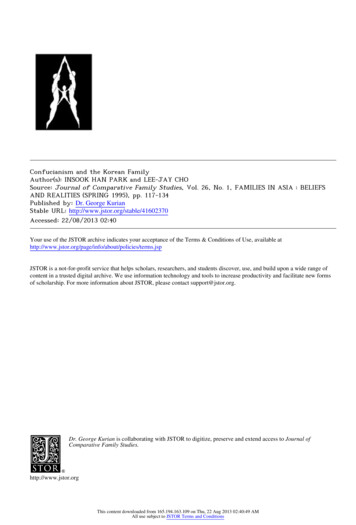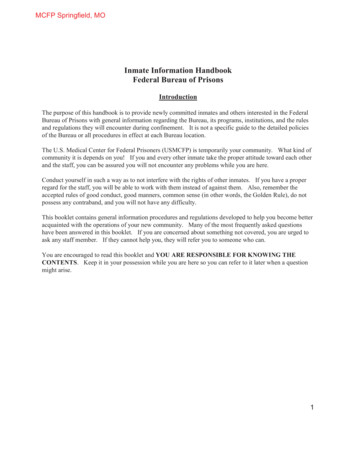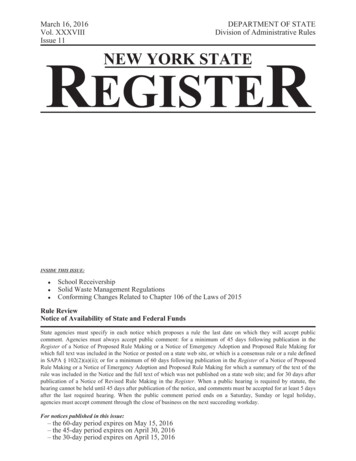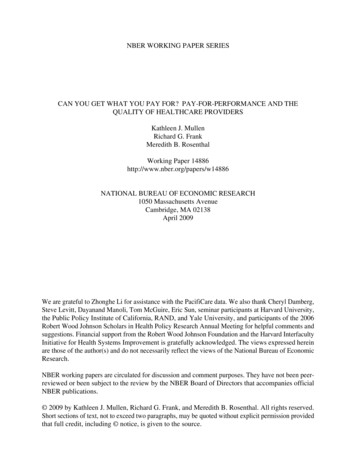
Transcription
NBER WORKING PAPER SERIESCAN YOU GET WHAT YOU PAY FOR? PAY-FOR-PERFORMANCE AND THEQUALITY OF HEALTHCARE PROVIDERSKathleen J. MullenRichard G. FrankMeredith B. RosenthalWorking Paper 14886http://www.nber.org/papers/w14886NATIONAL BUREAU OF ECONOMIC RESEARCH1050 Massachusetts AvenueCambridge, MA 02138April 2009We are grateful to Zhonghe Li for assistance with the PacifiCare data. We also thank Cheryl Damberg,Steve Levitt, Dayanand Manoli, Tom McGuire, Eric Sun, seminar participants at Harvard University,the Public Policy Institute of California, RAND, and Yale University, and participants of the 2006Robert Wood Johnson Scholars in Health Policy Research Annual Meeting for helpful comments andsuggestions. Financial support from the Robert Wood Johnson Foundation and the Harvard InterfacultyInitiative for Health Systems Improvement is gratefully acknowledged. The views expressed hereinare those of the author(s) and do not necessarily reflect the views of the National Bureau of EconomicResearch.NBER working papers are circulated for discussion and comment purposes. They have not been peerreviewed or been subject to the review by the NBER Board of Directors that accompanies officialNBER publications. 2009 by Kathleen J. Mullen, Richard G. Frank, and Meredith B. Rosenthal. All rights reserved.Short sections of text, not to exceed two paragraphs, may be quoted without explicit permission providedthat full credit, including notice, is given to the source.
Can You Get What You Pay For? Pay-For-Performance and the Quality of Healthcare ProvidersKathleen J. Mullen, Richard G. Frank, and Meredith B. RosenthalNBER Working Paper No. 14886April 2009JEL No. D23,H51,I12ABSTRACTDespite the popularity of pay-for-performance (P4P) among health policymakers and private insurersas a tool for improving quality of care, there is little empirical basis for its effectiveness. We use datafrom published performance reports of physician medical groups contracting with a large networkHMO to compare clinical quality before and after the implementation of P4P, relative to a controlgroup. We consider the effect of P4P on both rewarded and unrewarded dimensions of quality. In theend, we fail to find evidence that a large P4P initiative either resulted in major improvement in qualityor notable disruption in care.Kathleen J. MullenRAND Corporation1776 Main StreetP.O. Box 2138Santa Monica, CA 90407-2138kmullen@rand.orgRichard G. FrankDepartment of Health Care PolicyHarvard Medical School180 Longwood AvenueBoston, MA 02115and NBERfrank@hcp.med.harvard.eduMeredith B. RosenthalDepartment of Health Policy and ManagementHarvard School of Public Health677 Huntington AvenueBoston, MA 02115mrosenth@hsph.harvard.edu
1IntroductionIn 1999, the Institute of Medicine (IOM) issued a startling report estimating that, every year,between 44,000 and 98,000 people admitted to U.S. hospitals die as a result of preventable medicalerrors (IOM 1999). On average, U.S. patients receive only 55% of recommended care, includingregular screenings, follow-ups, and appropriate management of chronic diseases such as asthma anddiabetes (McGlynn et al. 2003). In response to widespread concerns over high rates of medical errorsand inconsistent healthcare quality that have persisted in the face of public reporting of quality,health policy makers and private insurers are turning to pay-for-performance (P4P) as a more directline of attack. More recently, the IOM cited over 100 P4P programs in place in private healthcaremarkets, and recommended that Medicare incorporate P4P into its reimbursement structure (IOM2006). As Mark McClellan, former Administrator of the Centers for Medicare and Medicaid Services(CMS), put it, “You get what you pay for. And we ought to be paying for better quality” (quotedin The New York Times, 2/22/06).In contrast to public reporting campaigns, which rely on consumer response to information,P4P programs focus their efforts on the price margin directly to motivate quality improvement. Atypical P4P program rewards healthcare providers (e.g., physician medical groups) with bonuses forhigh marks on one or more quality measures, such as rates of preventative screenings or adherenceto guidelines for chronic disease management (e.g., regular blood sugar testing for diabetics). Thesemeasures are based on clinical studies showing that better outcomes result when these processesare followed for patients meeting certain criteria. The rationale for pay-for-performance is simple.If quality of care becomes a direct component of their financial success, providers will shift moreresources towards quality improvement. Economic theory, however, suggests the story may not bethis simple. In particular, providers may shift resources toward rewarded dimensions of qualityat the expense of unrewarded dimensions, which may result in a decline in the overall quality ofpatient care.In this paper, we use data from the performance reports of medical groups contracting on acapitated basis with a large network HMO, PacifiCare Health Systems, before and after implementation of two P4P programs in California. We compare the performance of these groups to medicalgroups in the Pacific Northwest that were not affected by either program. In early 2002, PacifiCare2
announced the creation of a new Quality Incentive Program (QIP), which paid quarterly bonusesto medical groups performing at or above the 75th percentile from the preceding year on one ormore of five clinical quality measures. On average, PacifiCare accounts for 15% of total capitatedrevenues among medical groups in our sample. One year after the QIP went into effect, PacifiCarejoined forces with five other health plans in a coordinated P4P program sponsored by California’sIntegrated Healthcare Association (IHA), a nonprofit coalition of health plans, physician groups,hospitals, and purchasers. Together, the plans participating in the IHA program account for 60%of revenues for the medical groups in our data. Five of the six measures selected by the IHA werealso targets of the original PacifiCare program.We address two main questions. First, were either of these P4P programs effective at inducingchanges in quality of care? Second, if so, did the programs encourage healthcare providers todivert effort away from unrewarded towards rewarded dimensions of quality? We find that pay-forperformance did have a positive impact on some of the clinical measures rewarded by the programs,and the impact increased with the size of the average expected reward. However, we fail to findevidence that the programs either resulted in major improvement or notable disruption in care.Our data has several unique features which make it possible for us to investigate these questions.First, while PacifiCare announced its P4P program early in 2002, it has been collecting qualityinformation on its providers since 1993 and making that information public since 1998. This allowsus to estimate and control for pre-period trends in quality improvement irrespective of the QIP.We can also attribute any post-period trend breaks to the QIP without confounding our resultswith the effects of the public reporting. To control for macro shocks to quality trends, we havedata on a control group of PacifiCare providers in the Pacific Northwest where there is also publicreporting of quality of care but no P4P scheme. In addition, we have data on performance measuresnot explicitly rewarded, or differentially rewarded, by the incentive programs, which allows us toinvestigate spillover effects to other measures along rewarded and unrewarded dimensions of quality.Despite the rising popularity of P4P, little is known about how providers actually respondto such schemes. Randomized controlled trials of P4P are rare and tend to be small in scale.Additionally, P4P programs are often introduced at the same time as other quality improvementstrategies such as public reporting, making it difficult to isolate the effects of P4P. In a review ofthe empirical evidence on P4P, Rosenthal and Frank (2006) identified only seven published, peer3
reviewed studies of the impact of P4P in healthcare, with mixed results (zero or small positiveeffects on rewarded quality measures). These studies focused on outcomes such as flu vaccinations,childhood immunizations, and dispensation of smoking cessation advice, and they tended to besmall in terms of both sample size (15-60 medical groups or physicians) and financial impact (withpotential bonuses ranging from 500- 5,000 annually). In 2004, Britain’s National Health Servicerolled out a new P4P program for general practitioners. This program was much larger thanmost P4P programs in the U.S., with practices earning average bonuses of 133,200 (Doran etal. 2006). Campbell et al. (2007) estimated that quality indicators for asthma and diabetes (butnot coronary heart disease) improved in 2005 after P4P was implemented in the U.K., relativeto projected performance based on trends from 1998 to 2003. They found that rewarded andunrewarded measures improved about the same.We build on an earlier study by Rosenthal et al. (2005) which examined the effects of the PacifiCare intervention, on three clinical service measures rewarded by that program: cervical cancerscreening, breast cancer screening, and hemoglobin A1c testing for diabetics. Using a differencein-differences approach, they found that cervical cancer screening was the only measure with astatistically significant response to the program, on the order of 3 percentage points (10%). Ourpaper extends the time period of that study in order to separate the estimated effect of the PacifiCare intervention from that of the larger-scale, coordinated P4P program introduced roughly sixmonths into the post-period. In addition, we examine both measures that were explicitly rewardedby P4P and measures that were differentially rewarded, or not rewarded at all, by either P4P policy.In addition to contributing to the literature on quality improvement in healthcare, our papercontributes to the growing empirical literature on Holmstrom and Milgrom’s (1991) theory of multitasking (see, e.g., Jacob (2005) for an analysis of teachers’ responses to test-based accountability,and Lu (2009) for an application of multitasking theory to public reporting in the nursing homeindustry). We consider two ways in which medical groups can respond to P4P: (1) they can divert resources away from unrewarded measures to focus on the targeted measures; or (2) they canmake more general quality improvements, boosting both rewarded and unrewarded measures ofperformance. Which response dominates will depend on the technology of quality improvement inmedical practices, about which little is known. For example, screening and follow-up measures, suchas mammography and hemoglobin A1c (blood sugar) testing for diabetics, may both be increased4
by a general improvement in information technology, e.g., a computerized reminder program, despite differences in administration technique and patient populations. The degree of commonalityin the production of quality measures is crucial to whether we expect to see positive or negativespillovers.The remainder of the paper is organized as follows. In the next section we develop a modelof provider response to P4P. In Section 3, we introduce our natural experiment and discuss thefeatures of our data. In Section 4, we describe our estimation strategy for evaluating the effect ofP4P on the underlying dimensions of clinical quality, presenting the results in Section 5. We offerconcluding remarks in Section 6.2A Model of Provider Response to Pay-for-PerformanceConsider a principal-agent model in which the agent (e.g., physician medical group) chooses howmuch to invest in quality q, which is unobservable to the principal (payer, e.g., insurance company,which may or may not be acting on behalf of its patients). Quality may have several dimensions,i.e., q (q1 , ., qJ ). In our model, we abstract from the issue of quantity of services provided andfocus solely on the determination of quality. Let B(q) denote the benefit to the principal whenthe agent chooses quality level q, where B itself may be unobservable to the principal. Let C(q)denote the cost to the agent of producing quality at level q, where C is weakly increasing andstrictly convex. Costs can be fixed (e.g., a one-time investment in information technology, such asan automated reminder program) or variable (e.g., doctor time or effort).The principal observes a set of signals (quality indicators) y (y1 , ., yK ) that depend in parton q but do not fully reveal the agent’s choice of quality provided:y μ(q) ε(1)where εk q Fk , k 1, ., K, with E[εk q] 0 and E[εk εk0 q] 0. Let μjk denote yk / qj , whichreflects the marginal increase in the expected value of measure yk resulting from an increase inquality dimension qj . We assume that μ is fixed and taken as given by the provider. In otherwords, we assume that providers cannot “game” the measures, e.g., by selecting only patients with5
favorable attributes. The concern that P4P could encourage “cream skimming” is widespread, andthe measures we examine were chosen to minimize opportunities for patient selection.1 For the mostpart, the measures we examine are diagnostically narrow process measures; that is they evaluateactions taken by providers and so they rely little on inputs from patients (who are all commerciallyinsured in our setting). In addition, the measures are audited by the National Committee forQuailty Assurance.In our model, the measures can only increase (in expected value) if one or more of the underlyingquality dimensions changes. If two measures yk and yk0 both depend positively on qj , then we say acommonality exists in the production of measures yk and yk0 . An example of this is the automatedreminder program, which may increase the number of patients screened for diseases or examinedfor follow-up care, regardless of specifics regarding patient population or administration techniqueof a particular test/exam.Let R(y) denote the compensation of the agent. In the benchmark case, where compensationdoes not depend on quality, R(y) r0 . Then the agent chooses q to minimize cost: C 0, j 1, ., J. qj(2)Note that in a capitated environment the provider may save money by providing quality (e.g.,screening for some health problems may be cost-effective if the resultant costs of care are high.)2Unless C(q) B(q), the agent sets q lower than the efficient level. This suggests there is roomfor improvement if R can depend on q, even if indirectly through y.Now assume that a target-based P4P bonus scheme is instituted, in which the agent is rewardedadditionally on yk only if yk reaches a predetermined absolute target level Tk , for k 1, ., K:R(y) r0 KXk 1rk I (yk Tk ) .1Shen (2003) found that performance-based contracting encouraged Maine’s Office of Substance Abuse to selectively drop harder-to-treat patients. Similarly, Dranove et al. (2003) found that public reporting of cardiac surgeryoutcomes encouraged selection against sicker patients. Note, however, that it is far from clear that this last form ofpatient selection is always undesireable. In particular, there is no reason to believe that the current system, whichdoes not reward doctors on any aspects of quality, provides the “right” incentives for doctors to decide who maybenefit for more or less aggressive treatment.2We can allow for some altruism on the part of providers, e.g., providers maximize R(y) αB(q) C(q), but thisdoes not change our results qualitatively, as long as providers are imperfect agents, i.e., α 1.6
Assume that the agent is risk neutral, and maximizes expected profitsE[R(y)] C(q) r0 r0 KXk 1KXk 1rk Pr(yk Tk ) C(q)rk [Fk (μ(q) Tk )] C(q)where Fk is the cumulative density function of εk , k 1, ., K. The first order condition isKX C rk μjk fk (μ(q) Tk ) , j 1, ., J. qj(3)k 1This simply states that medical groups choose q by setting the marginal cost of quality improvementequal to the expected marginal revenue from increasing q. Ignoring cross partial effects in the costfunction, if rk μjk 0, for all k, and rk μjk 0 for at least one k, then quality along dimension j willincrease as a result of P4P, since the right-hand side of (3) is greater than zero. Figure 1 illustratesthe effect of P4P in the simple case of J K 1 and y q. Initial quality, q0, is the value ofq for which the marginal cost of quality improvement is zero. Assume that target-based P4P isintroduced where the target T is set above initial quality. Under P4P, quality increases to q1, wherethe marginal cost curve intersects the marginal revenue curve assuming a symmetric distributionfor ε (e.g., the normal distribution). If f is symmetric, then marginal (expected) revenue is greatestjust at the target, where q T.A common criticism of target-based P4P programs is that the target structure discourages verylow performers and very high performers from improving. Figure 1 illustrates this clearly. As theabsolute value of the distance q T increases, the marginal revenue from P4P goes to zero, so thereis very little incentive to improve. On the other hand, P4P will have its largest impact at somelevel of initial quality strictly less than the target level. To see this, consider a linear marginalcost curve C/ q q0i /c cq, where providers differ in their initial quality q0i only. Since f isdecreasing in absolute distance from T , q1i q0i is maximized at q1i T, which implies that P4Phas its greatest effect for providers with an initial quality of q0i T rf (0)/c T. Note thatthis level is decreasing in r and increasing in c; that is, as the bonus amount increases (or, as the7
marginal cost curve flattens) lower performing providers find it increasingly worthwhile to improvein response to P4P.Ignoring initial differences in quality, the marginal benefit to increasing qj can be decomposedinto μjk , the marginal increase in observed measure yk , and rk , the price received for each additionalPunit of yk , k 1, ., K. A P4P scheme favors quality dimension qj relative to qj 0 if Kk 1 rk (μjk μj 0 k ) 0 (assuming the overall probabilities of reaching the targets are the same).In general,however, 2 C/ qj qj 0 Cjj 0 6 0, so that changing quality along some other dimension j 0 6 jwill shift the marginal cost curve up or down depending on the sign of Cjj 0 . If Cjj 0 0 (qualitydimensions j and j 0 are substitutes) and if P4P places a large premium on quality dimension j 0 ,then C/ qj may shift up enough to reduce quality dimension j to a level lower than its initiallevel before P4P was instituted. Note that the model predicts that it is relative prices rk μjk thatmatter; it is not necessary for rk 0 for P4P to induce a negative response on measure yk if yklargely reflects a quality dimension j that is weakly reflected in other highly rewarded measures.Finally, the model predicts that μ plays a crucial role in determining which measures willchange, and in which directions, as a result of P4P. Suppose, for example, that we add a newmeasure yK 1 , but yK 1 is not rewarded by P4P. Assume there are two dimensions of quality,and that P4P strongly rewards the first dimension. Then yK 1 will increase if the increase inyK 1 due to the increase in q1 is not offset by the decrease in yK 1 due to the decrease in q2(μ1,K 1 q1 μ2,K 1 q2 ). In other words, we can predict that the unrewarded measure yK 1will increase in response to P4P if we have a priori reason to believe that it is strongly relatedto the quality dimension(s) determining the rewarded measure set (or, in the case of differentialbonuses, the more lucratively rewarded set). Similarly, if yK 1 is weakly related or unrelated to themore lucrative quality dimensions, we may expect it to respond negatively to P4P. Certainly if webelieved a priori that yK 1 should be strongly related in terms of underlying quality to measuresfor which we observe a negative response to P4P, then we would expect yK 1 to respond negativelyas well. These theoretical insights will provide guiding intuitions for the empirical results below.8
3SettingWe use data from published performance reports of multispecialty medical groups in Californiaand the Pacific Northwest contracting on a capitated basis with a network HMO, PacifiCare HealthSystems.3 PacifiCare is one of the nation’s largest health plans, ranked 5th in commercial enrollmentby Atlantic Information Systems in 2003. PacifiCare has been collecting quality information onits providers since 1993, although it did not begin making the reports public until 1998. Many ofthe measures are adapted from the Healthcare Effectiveness Data and Information Set (HEDIS),developed by the National Committee for Quality Assurance (NCQA) and the accepted standardin quality measurement.In March 2002, PacifiCare of California announced that, as part of a new Quality IncentiveProgram (QIP) starting in July 2003, it would begin paying quarterly performance bonuses based onon selected quality measures published in the reports. Since the reports measured performance overthe preceding year with a lag of six months, the first payout in July 2003 corresponded to patientcare which took place between January 1, 2002 and December 31, 2002. We obtained data fromseventeen quarterly performance reports issued between July 2001 and July 2005, corresponding topatient care delivered between January 1, 2000 and December 31, 2004. Table 1 summarizes thetime structure of our data. Since the provisions of the QIP were not incorporated into the contractswith most of the groups until July 2002, the earliest we may be able to detect a response wouldbe in the April 2003 report (the 8th quarter in our data set). Eligiblity was based on the size ofthe Commercial (CO) and Secure Horizons (SH; covered by Medicare) patient population. Initially172 medical groups were eligible for the program, with 70 additional groups in the second year.PacifiCare set targets for five clinical measures at the 75th percentile of performance in thepreceding year (2001), and eligible groups received a quarterly bonus of 0.6795 per SH memberfor each target met or exceeded. Thus, a group with 2,183 SH members (the average number of SHmembers in 2002) could receive a potential bonus of up to 7,417 quarterly, or 29,667 annually,if it met all five clinical targets.4 Table 2 lists the clinical quality measures rewarded by the QIP3Under capitation, healthcare providers are paid a fixed amount periodically for each enrolled patient. Individualmedical groups may choose to pay or reimburse their member physicians differently.4The program also rewarded performance on five service measures, which were calculated from patient satisfactionsurveys, as well as six hospital patient safety measures, which were essentially structural quality measures. We ignorethis aspect of the program in this paper and concentrate solely on clinical quality as measured by process and outcomemeasures.9
program with their corresponding thresholds. Table 3 presents the mean and median potentialbonuses that providers could earn if they met or exceeded these thresholds. Summary statistics forthe clinical measures, by region and year, are reported in the Appendix. After one year, PacifiCareadded five clinical quality measures and readjusted the bonus calculation scheme to allow for asecond tier of performance, set at the 85th percentile of the preceding year (2002) and worth twiceas much as the first tier. However, the QIP was quickly overshadowed by a much larger P4P effortlaunched by the Integrated Healthcare Association (IHA) after its first year.The IHA is a nonprofit statewide coalition of health plans, physician groups, hospitals andpurchasers. Six California health plans - Aetna, Blue Cross of California, Blue Shield of California,CIGNA Healthcare of California, Health Net, and PacifiCare - agreed to pay bonuses to participating California medical groups for performance on a common measure set. These health plans beganpaying annual bonuses in mid-2004 for patient care delivered in 2003. (A seventh plan, WesternHealth Advantage, joined the program in its second year.) Table 2 reports the IHA measure setsfor 2003 and 2004. Note that the IHA added appropriate asthma medication, but otherwise paidon the same measures as the QIP in its first year. Unlike the QIP, the IHA program was announceda year before it went into effect. In the absence of the QIP, we could have seen if medical groupsimproved quality in anticipation of the implementation date. As a result, we cannot disentanglethe “IHA anticipation effect” from the pure impact of the QIP. We take January 2003 to be thestart date for the IHA initiative, corresponding to the October 2003 report (the 10th quarter inour data), recognizing that we cannot tell when providers actually started responding to the IHA,if they did so before this date.The successive introduction of the QIP and IHA programs provides a unique opportunity toexamine the responses of medical groups to different aspects of P4P programs. First, when theother plans in the IHA coalition adopted P4P, this dramatically increased the size of potentialbonuses (on the order of ten times for the average group). Together, the health plans participatingin the IHA program accounted for an average of roughly 60% of capitated revenues of the Californiamedical groups.5 Total performance payments from IHA-affiliated groups (including payments for5Glied and Zivin (2002) provide evidence that, in a mixed payment environment, healthcare providers respondto the incentives of their modal patient. Unfortunately, we do not have data on PacifiCare or IHA’s share of totalenrollment, so we cannot distinguish between the dual channels of increasing the amounts of the payments andincreasing the “salience” of the program.10
non-clinical and non-IHA performance measures) amounted to more than 122.7 million in 2004and 139.5 million in 2005. PacifiCare’s QIP accounted for only 16% of the total payout in 2004,and only 10% in 2005. The IHA program was not just bigger in terms of absolute dollar amounts,but it also made performance bonuses attainable for the lower performing groups, since the biggestpayers like Blue Cross and Blue Shield made payments to groups above the 20th and 30th percentile,respectively. Although the measure set was common across health plans, each plan individuallydecided on the size and structure of the awards it offered. In particular, PacifiCare and Health Netwere the only plans to use absolute thresholds for determining payment; the rest of the plans basedtheir payments on relative rankings of providers. (See Damberg et al. (2005) for more details onthe IHA program; in addition, the IHA’s Financial Transparency Reports are publicly available athttp://www.iha.org.) Thus, part of the increase in dollars paid can be attributed to the fact thatPacifiCare had stricter requirements (i.e., higher thresholds).The interaction of the QIP and IHA programs also provides a unique opportunity to examine theresponses of medical groups when measure sets diverge. In the first six months of P4P, Californiamedical groups were paid small bonuses for performance on five measures which rely primarily onidentifying patients in appropriate risk groups and successfully scheduling patient visits.6 The IHAprogram increased the size of the bonuses for these identification/scheduling (IS) measures, whileat the same time PacifiCare added five new measures which rely primarily on doctors’ prescribingand managing the right medications (as well as outcomes, which, theoretically, could be controlledwith optimal outpatient care). In other words, these measures could potentially be improved byfocusing on interventions at the doctor level (MD).Thus, we can estimate responses to P4P when one type of measure is rewarded more or lessthan others (where “type” refers to measures grouped on commonalities in production). As we sawin Section 2, in theory even a rewarded measure could decrease in response to a P4P program thatprovides substantially higher rewards to other measures (a relative price effect). If this is the case,then it underscores the fact that payers considering implementing P4P should take into accountany other existing or proposed incentive programs. In the next section, we describe the empirical6For the most part, the measures do not correlate very highly. However, note that cervical cancer screening,hemoglobin A1c testing, and chlamydia screening are all highly correlated with one another, on the order of 0.50.7, lending some support to our hypothesis that these measures may have similar production technologies despitedifferences in patient population.11
specifications that we estimate and explain how they relate to our hypotheses about providers’responses to P4P.4Empirical StrategyTo examine healthcare providers’ responses to the introduction of P4P in California, we use longitudinal data on fourteen clinical quality measures, nine of which were rewarded by one or morehealth plans at some point during the period we study.7 All but one of our measures are rates, forwhich we have data on both numerators and denominators (where the denominator represents thenumber of PacifiCare patients enrolled in the medical group who are clinically indicated to receivea screening or treatment). We restrict our sample to medical groups with complete data on one ormore measures reported in the July 2001 to July 2005 Performance Profiles published by PacifiCare.Note that some measures are not available for all seventeen quarters due to definition changes andthe introduction of new measures. We consider only those measures reported at least two quartersbefore the first wave of P4P began. Note that we also observe a number of mergers between medi
QUALITY OF HEALTHCARE PROVIDERS . w14886 NATIONAL BUREAU OF ECONOMIC RESEARCH 1050 Massachusetts Avenue Cambridge, MA 02138 April 2009 We are grateful to Zhonghe Li for assistance with the PacifiCare data. We also thank Cheryl Damberg, Steve Levitt, Dayanand Manoli, Tom McGuire, Eric Sun, seminar participants at Harvard University, the Public .
